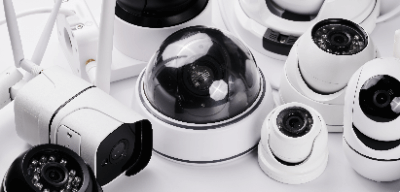What Is a CCTV Lens?
A CCTV Lens is a lens for CCTV cameras (Closed Circuit Television). These camaras transmit their images only to a specific receiver (TV monitor), such as a closed circuit television. CCTV lenses provide balanced aberration correction for all subjects, making them suitable for reading a wide range of images.
Uses of CCTV Lenses
CCTV Lenses are used in CCTV cameras, which are mainly used for security applications such as surveillance and security cameras.
Other applications include road monitoring, image recognition, bar code scanning, high-speed image processing, medical applications, and machine and robot vision. In recent years, it has become possible to support mega-pixel lenses for cameras with higher pixel counts and coding for special wavelengths such as infrared rays.
Principle of CCTV Lens
CCTV Lenses have traditionally been used primarily for surveillance purposes, so they provide balanced aberration correction for all object distances. As a result, their individual physical characteristics may be inferior to those of fixed magnification telecentric or macro lenses. Also, as general-purpose lenses, their appearance is important, and their external dimensions are larger.
Types of CCTV Lenses
CCTV Lens, like most camera lenses, are available in a variety of focal lengths. Shorter focal lengths provide a wider field of view, while longer focal lengths are telephoto lenses with a narrower field of view and larger images of distant objects.
The image sensors of CCTV cameras are also classified according to the size of the image sensor: most CCTV camera image sensors are 1/1.8″, 2/3″, 1/2.7″, 1/3″, and 1″ in size. There are two types of mounts for connecting to the camera: C-mount and CS-mount.
Other Information on CCTV Lens
1. Magnification of CCTV Lens
Magnification generally refers to optical magnification, which is the ratio of camera size to field of view. Camera size is the pixel size multiplied by the number of effective pixels, which is how many times the object is to be imaged. The information needed to calculate magnification is the W.D: work distance – the distance from the lens to the subject) and the focal length – the distance from the lens to the camera element.
If the distance to the subject is the same, the shorter the focal length, the wider the field of view, and the lens is called a wide-angle lens. When the same size subject is projected, the longer the focal length, the longer the work distance, and is called a telephoto lens.
Thus, in selecting a camera and lens, the first step is to select the magnification, followed by the selection of a lens and camera that match the installation conditions. Therefore, the first requirement for selection is to set the appropriate magnification for the application.
2. Focal Length of CCTV Lens
After determining the magnification, the lens and camera are selected according to the installation conditions. In selecting a camera, the number of pixels and CCD size are the basic factors to be taken into consideration.
In the use of cameras in industrial facilities, many lenses with fixed focal lengths are used. Therefore, there is a range of work distances that can be used, and a lens that provides the required field of view within the range of use must be selected.
Generally, the longer the focal length, the longer the work distance; CCTV Lens is not suitable for high-magnification applications, so a macro lens or similar is effective for imaging at high magnification. Spacers can also be placed between the lens and the camera to extend the focal length. The field of view and work distance when spacers are used are also listed in the manufacturer’s technical data.
In camera and lens installations, it is common to use work distance to adjust for focus, and mounting the camera on a manual stage or similar device that can be adjusted in the imaging direction is convenient during adjustment.
